SWOT Analysis of Hong Kong International Airport
VerifiedAdded on 2023/06/13
|17
|5069
|91
AI Summary
This article provides a SWOT analysis of the Hong Kong International Airport, including its strengths, weaknesses, opportunities, and threats. It also discusses the financial performance of the airport and provides recommendations for improving profitability.
Contribute Materials
Your contribution can guide someone’s learning journey. Share your
documents today.
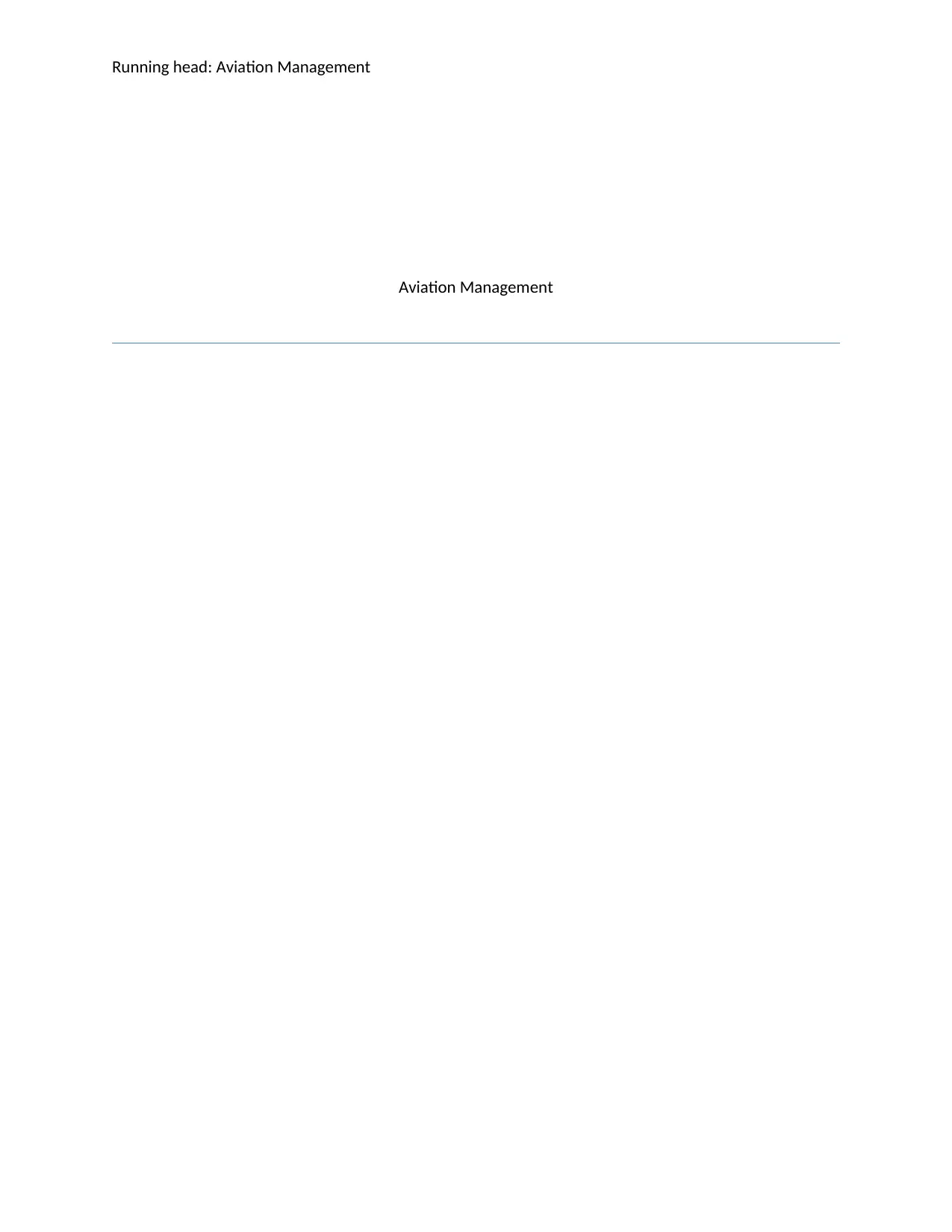
Running head: Aviation Management
Aviation Management
Aviation Management
Secure Best Marks with AI Grader
Need help grading? Try our AI Grader for instant feedback on your assignments.
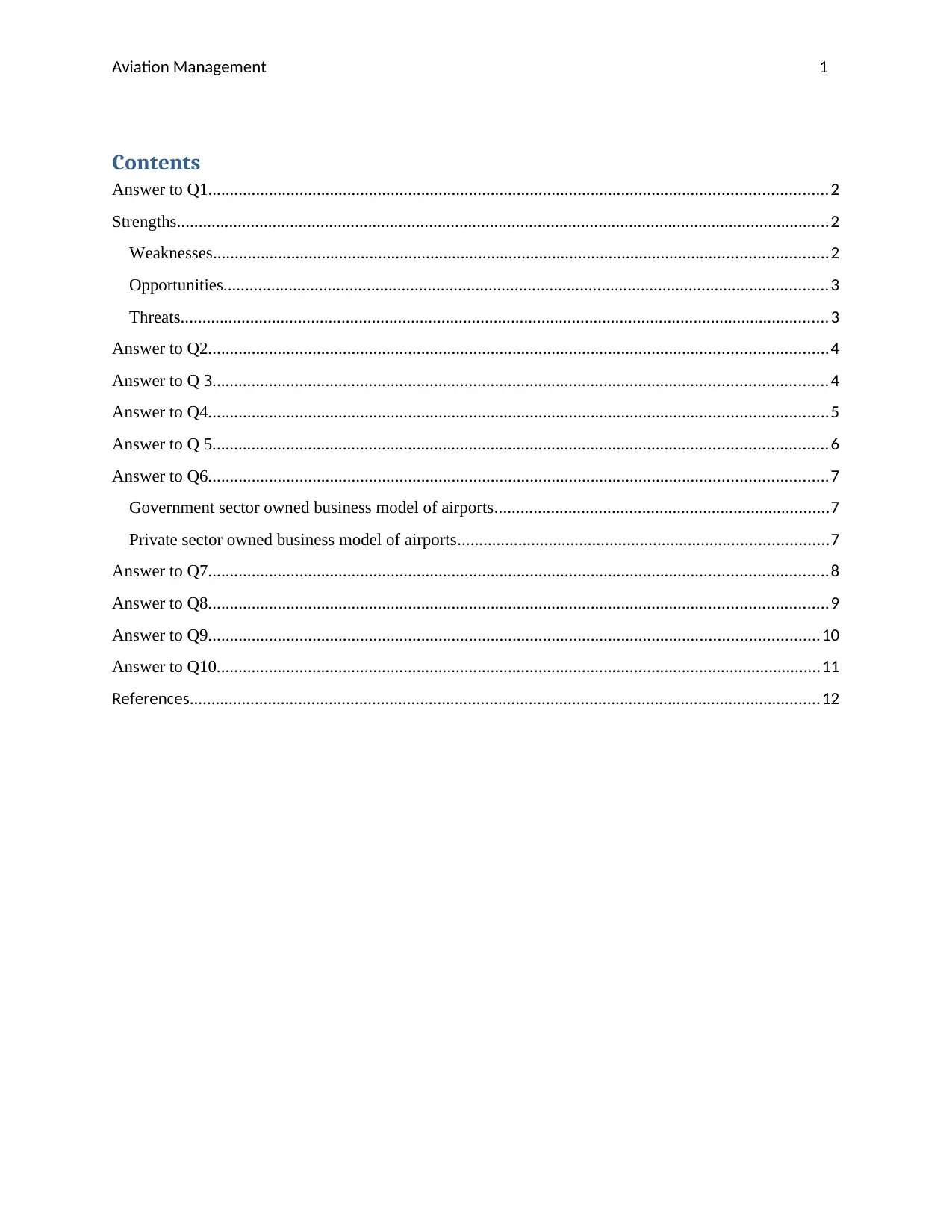
Aviation Management 1
Contents
Answer to Q1..............................................................................................................................................2
Strengths......................................................................................................................................................2
Weaknesses.............................................................................................................................................2
Opportunities...........................................................................................................................................3
Threats.....................................................................................................................................................3
Answer to Q2..............................................................................................................................................4
Answer to Q 3.............................................................................................................................................4
Answer to Q4..............................................................................................................................................5
Answer to Q 5.............................................................................................................................................6
Answer to Q6..............................................................................................................................................7
Government sector owned business model of airports.............................................................................7
Private sector owned business model of airports.....................................................................................7
Answer to Q7..............................................................................................................................................8
Answer to Q8..............................................................................................................................................9
Answer to Q9............................................................................................................................................10
Answer to Q10...........................................................................................................................................11
References.................................................................................................................................................12
Contents
Answer to Q1..............................................................................................................................................2
Strengths......................................................................................................................................................2
Weaknesses.............................................................................................................................................2
Opportunities...........................................................................................................................................3
Threats.....................................................................................................................................................3
Answer to Q2..............................................................................................................................................4
Answer to Q 3.............................................................................................................................................4
Answer to Q4..............................................................................................................................................5
Answer to Q 5.............................................................................................................................................6
Answer to Q6..............................................................................................................................................7
Government sector owned business model of airports.............................................................................7
Private sector owned business model of airports.....................................................................................7
Answer to Q7..............................................................................................................................................8
Answer to Q8..............................................................................................................................................9
Answer to Q9............................................................................................................................................10
Answer to Q10...........................................................................................................................................11
References.................................................................................................................................................12
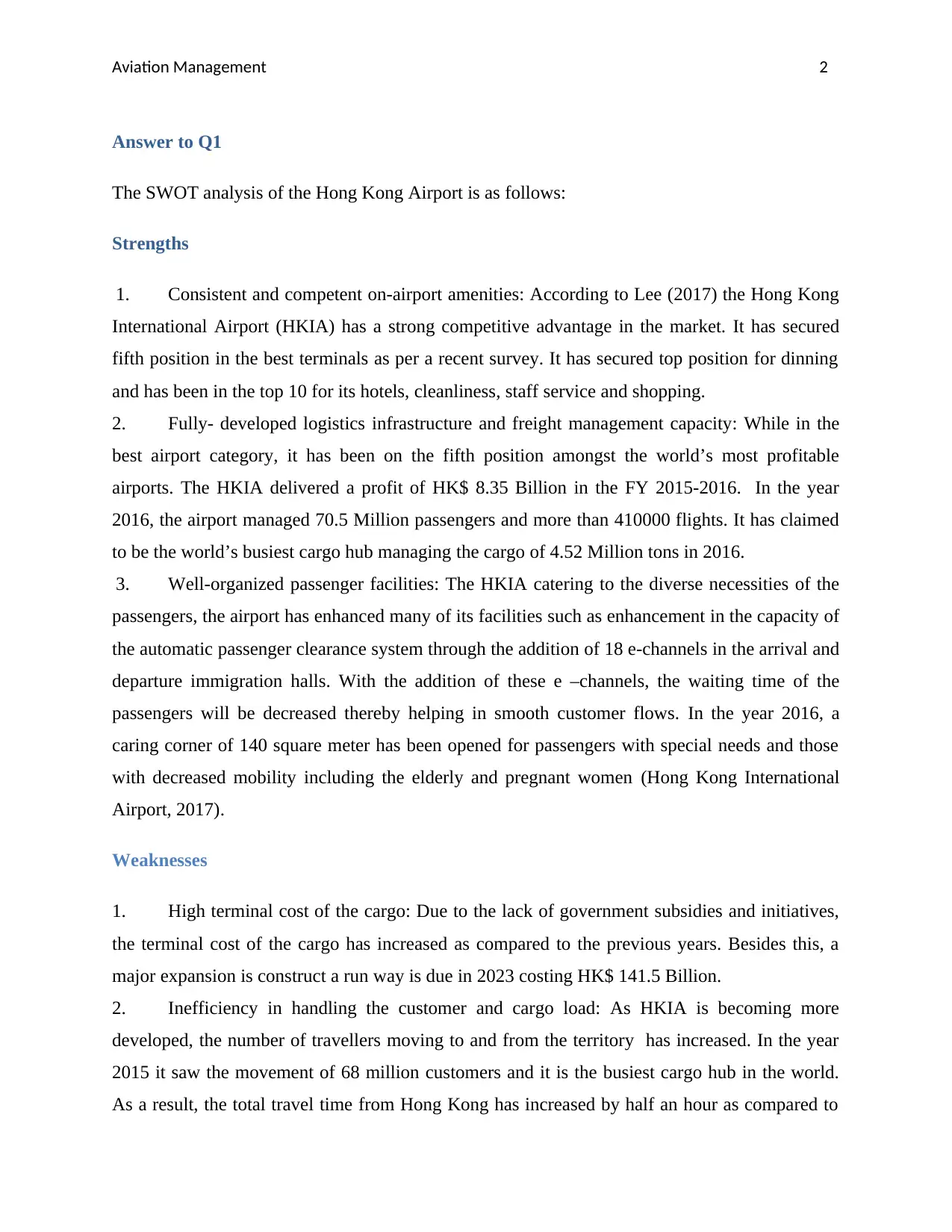
Aviation Management 2
Answer to Q1
The SWOT analysis of the Hong Kong Airport is as follows:
Strengths
1. Consistent and competent on-airport amenities: According to Lee (2017) the Hong Kong
International Airport (HKIA) has a strong competitive advantage in the market. It has secured
fifth position in the best terminals as per a recent survey. It has secured top position for dinning
and has been in the top 10 for its hotels, cleanliness, staff service and shopping.
2. Fully- developed logistics infrastructure and freight management capacity: While in the
best airport category, it has been on the fifth position amongst the world’s most profitable
airports. The HKIA delivered a profit of HK$ 8.35 Billion in the FY 2015-2016. In the year
2016, the airport managed 70.5 Million passengers and more than 410000 flights. It has claimed
to be the world’s busiest cargo hub managing the cargo of 4.52 Million tons in 2016.
3. Well-organized passenger facilities: The HKIA catering to the diverse necessities of the
passengers, the airport has enhanced many of its facilities such as enhancement in the capacity of
the automatic passenger clearance system through the addition of 18 e-channels in the arrival and
departure immigration halls. With the addition of these e –channels, the waiting time of the
passengers will be decreased thereby helping in smooth customer flows. In the year 2016, a
caring corner of 140 square meter has been opened for passengers with special needs and those
with decreased mobility including the elderly and pregnant women (Hong Kong International
Airport, 2017).
Weaknesses
1. High terminal cost of the cargo: Due to the lack of government subsidies and initiatives,
the terminal cost of the cargo has increased as compared to the previous years. Besides this, a
major expansion is construct a run way is due in 2023 costing HK$ 141.5 Billion.
2. Inefficiency in handling the customer and cargo load: As HKIA is becoming more
developed, the number of travellers moving to and from the territory has increased. In the year
2015 it saw the movement of 68 million customers and it is the busiest cargo hub in the world.
As a result, the total travel time from Hong Kong has increased by half an hour as compared to
Answer to Q1
The SWOT analysis of the Hong Kong Airport is as follows:
Strengths
1. Consistent and competent on-airport amenities: According to Lee (2017) the Hong Kong
International Airport (HKIA) has a strong competitive advantage in the market. It has secured
fifth position in the best terminals as per a recent survey. It has secured top position for dinning
and has been in the top 10 for its hotels, cleanliness, staff service and shopping.
2. Fully- developed logistics infrastructure and freight management capacity: While in the
best airport category, it has been on the fifth position amongst the world’s most profitable
airports. The HKIA delivered a profit of HK$ 8.35 Billion in the FY 2015-2016. In the year
2016, the airport managed 70.5 Million passengers and more than 410000 flights. It has claimed
to be the world’s busiest cargo hub managing the cargo of 4.52 Million tons in 2016.
3. Well-organized passenger facilities: The HKIA catering to the diverse necessities of the
passengers, the airport has enhanced many of its facilities such as enhancement in the capacity of
the automatic passenger clearance system through the addition of 18 e-channels in the arrival and
departure immigration halls. With the addition of these e –channels, the waiting time of the
passengers will be decreased thereby helping in smooth customer flows. In the year 2016, a
caring corner of 140 square meter has been opened for passengers with special needs and those
with decreased mobility including the elderly and pregnant women (Hong Kong International
Airport, 2017).
Weaknesses
1. High terminal cost of the cargo: Due to the lack of government subsidies and initiatives,
the terminal cost of the cargo has increased as compared to the previous years. Besides this, a
major expansion is construct a run way is due in 2023 costing HK$ 141.5 Billion.
2. Inefficiency in handling the customer and cargo load: As HKIA is becoming more
developed, the number of travellers moving to and from the territory has increased. In the year
2015 it saw the movement of 68 million customers and it is the busiest cargo hub in the world.
As a result, the total travel time from Hong Kong has increased by half an hour as compared to

Aviation Management 3
1999. So, the limitations will also affect the mobility of the transport planes which will slow
down the economic growth of the territory.
3. Lack of proper management: According to Cheng (2015) the existing runways are
underutilized and HKIA is planning to construct another runway. The construction of third
runway would increase the depletion of the natural environment and is a mere wastage of
resources. The director general of civil aviation has restricted the aircraft movements to 64
flights per hour which is below the international standards. The efficiency can only be improved
by enhancing the efficiency of the runway so that it can manage more aircraft movements.
Opportunities
1. Increased demand for budget airlines: According to Sze et al. (2015) there is an
increasing demand for budgeted airlines. As per the recent research executed by the Public
Opinion Program at the University of Hong Kong, about 70 % of citizens of Hong Kong
expressed their interest in travelling on a lost cost carrier. So, there are huge possibilities for the
growth of the budgeted airlines on the HKIA.
2. Competitive geographical location: The duration to reach the HKIA from countries
including India and China is less than five flying hours. It has made HKIA competitive in the
budget airline industry.
Threats
1. Limitations of the Hong Kong International Airport and its policies: The Hong Kong
International Airport is a challenging market for budget carriers as it has high servicing costs and
is more restricted. The HKIA being a single airport has high landing fees. The airport does not
grant any discounts on the landing fees to the budgeted airlines. So as a result there are
problems relating to the competitive from allotment for slots and high landing fees which can
hamper the development of the airport.
2. Slot congestion and traditional modes of air traffic control: The HKIA is already running
at its full capacity. With the warning of the aviation officials, drastic measures are needed to
divert the air traffic and cargo air carriers.
1999. So, the limitations will also affect the mobility of the transport planes which will slow
down the economic growth of the territory.
3. Lack of proper management: According to Cheng (2015) the existing runways are
underutilized and HKIA is planning to construct another runway. The construction of third
runway would increase the depletion of the natural environment and is a mere wastage of
resources. The director general of civil aviation has restricted the aircraft movements to 64
flights per hour which is below the international standards. The efficiency can only be improved
by enhancing the efficiency of the runway so that it can manage more aircraft movements.
Opportunities
1. Increased demand for budget airlines: According to Sze et al. (2015) there is an
increasing demand for budgeted airlines. As per the recent research executed by the Public
Opinion Program at the University of Hong Kong, about 70 % of citizens of Hong Kong
expressed their interest in travelling on a lost cost carrier. So, there are huge possibilities for the
growth of the budgeted airlines on the HKIA.
2. Competitive geographical location: The duration to reach the HKIA from countries
including India and China is less than five flying hours. It has made HKIA competitive in the
budget airline industry.
Threats
1. Limitations of the Hong Kong International Airport and its policies: The Hong Kong
International Airport is a challenging market for budget carriers as it has high servicing costs and
is more restricted. The HKIA being a single airport has high landing fees. The airport does not
grant any discounts on the landing fees to the budgeted airlines. So as a result there are
problems relating to the competitive from allotment for slots and high landing fees which can
hamper the development of the airport.
2. Slot congestion and traditional modes of air traffic control: The HKIA is already running
at its full capacity. With the warning of the aviation officials, drastic measures are needed to
divert the air traffic and cargo air carriers.
Secure Best Marks with AI Grader
Need help grading? Try our AI Grader for instant feedback on your assignments.
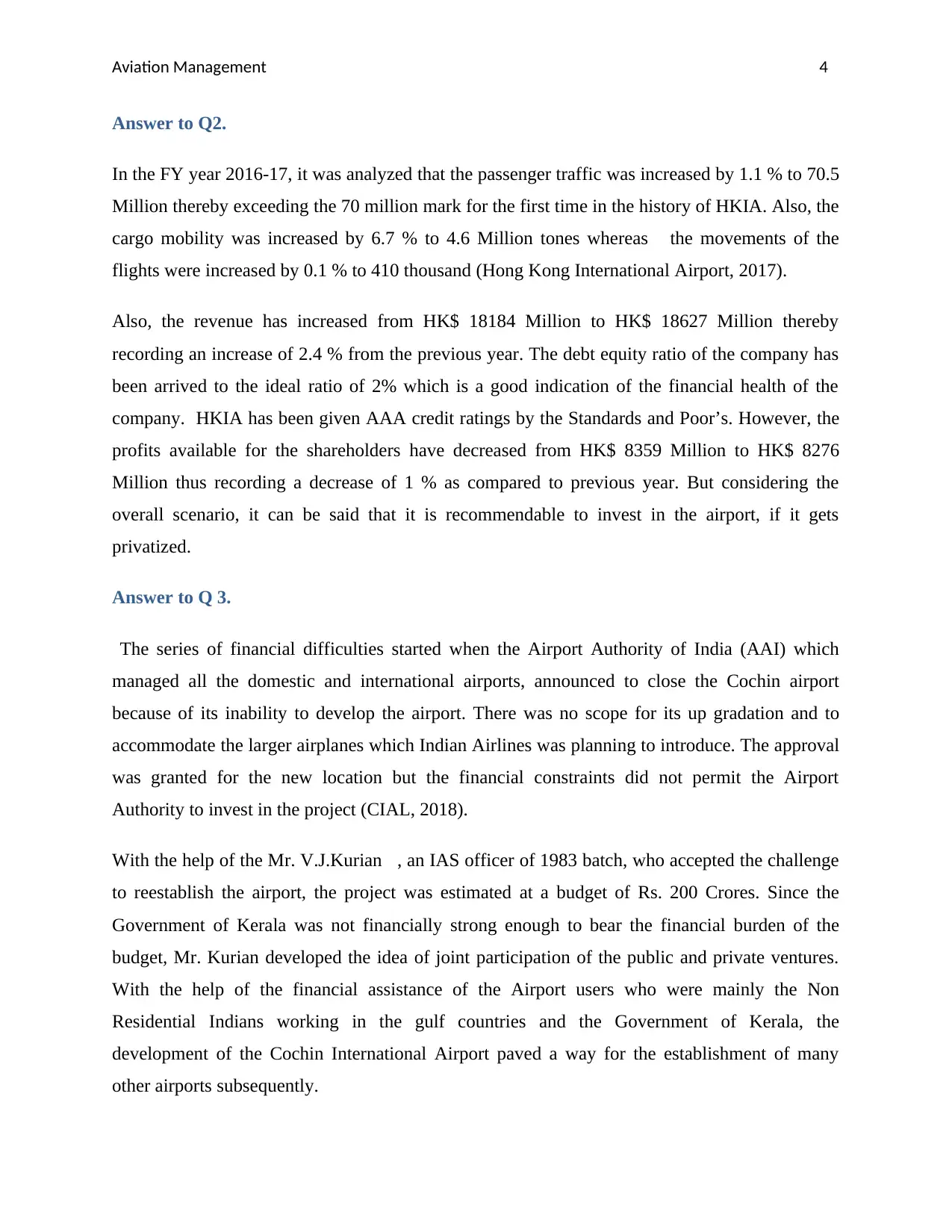
Aviation Management 4
Answer to Q2.
In the FY year 2016-17, it was analyzed that the passenger traffic was increased by 1.1 % to 70.5
Million thereby exceeding the 70 million mark for the first time in the history of HKIA. Also, the
cargo mobility was increased by 6.7 % to 4.6 Million tones whereas the movements of the
flights were increased by 0.1 % to 410 thousand (Hong Kong International Airport, 2017).
Also, the revenue has increased from HK$ 18184 Million to HK$ 18627 Million thereby
recording an increase of 2.4 % from the previous year. The debt equity ratio of the company has
been arrived to the ideal ratio of 2% which is a good indication of the financial health of the
company. HKIA has been given AAA credit ratings by the Standards and Poor’s. However, the
profits available for the shareholders have decreased from HK$ 8359 Million to HK$ 8276
Million thus recording a decrease of 1 % as compared to previous year. But considering the
overall scenario, it can be said that it is recommendable to invest in the airport, if it gets
privatized.
Answer to Q 3.
The series of financial difficulties started when the Airport Authority of India (AAI) which
managed all the domestic and international airports, announced to close the Cochin airport
because of its inability to develop the airport. There was no scope for its up gradation and to
accommodate the larger airplanes which Indian Airlines was planning to introduce. The approval
was granted for the new location but the financial constraints did not permit the Airport
Authority to invest in the project (CIAL, 2018).
With the help of the Mr. V.J.Kurian , an IAS officer of 1983 batch, who accepted the challenge
to reestablish the airport, the project was estimated at a budget of Rs. 200 Crores. Since the
Government of Kerala was not financially strong enough to bear the financial burden of the
budget, Mr. Kurian developed the idea of joint participation of the public and private ventures.
With the help of the financial assistance of the Airport users who were mainly the Non
Residential Indians working in the gulf countries and the Government of Kerala, the
development of the Cochin International Airport paved a way for the establishment of many
other airports subsequently.
Answer to Q2.
In the FY year 2016-17, it was analyzed that the passenger traffic was increased by 1.1 % to 70.5
Million thereby exceeding the 70 million mark for the first time in the history of HKIA. Also, the
cargo mobility was increased by 6.7 % to 4.6 Million tones whereas the movements of the
flights were increased by 0.1 % to 410 thousand (Hong Kong International Airport, 2017).
Also, the revenue has increased from HK$ 18184 Million to HK$ 18627 Million thereby
recording an increase of 2.4 % from the previous year. The debt equity ratio of the company has
been arrived to the ideal ratio of 2% which is a good indication of the financial health of the
company. HKIA has been given AAA credit ratings by the Standards and Poor’s. However, the
profits available for the shareholders have decreased from HK$ 8359 Million to HK$ 8276
Million thus recording a decrease of 1 % as compared to previous year. But considering the
overall scenario, it can be said that it is recommendable to invest in the airport, if it gets
privatized.
Answer to Q 3.
The series of financial difficulties started when the Airport Authority of India (AAI) which
managed all the domestic and international airports, announced to close the Cochin airport
because of its inability to develop the airport. There was no scope for its up gradation and to
accommodate the larger airplanes which Indian Airlines was planning to introduce. The approval
was granted for the new location but the financial constraints did not permit the Airport
Authority to invest in the project (CIAL, 2018).
With the help of the Mr. V.J.Kurian , an IAS officer of 1983 batch, who accepted the challenge
to reestablish the airport, the project was estimated at a budget of Rs. 200 Crores. Since the
Government of Kerala was not financially strong enough to bear the financial burden of the
budget, Mr. Kurian developed the idea of joint participation of the public and private ventures.
With the help of the financial assistance of the Airport users who were mainly the Non
Residential Indians working in the gulf countries and the Government of Kerala, the
development of the Cochin International Airport paved a way for the establishment of many
other airports subsequently.
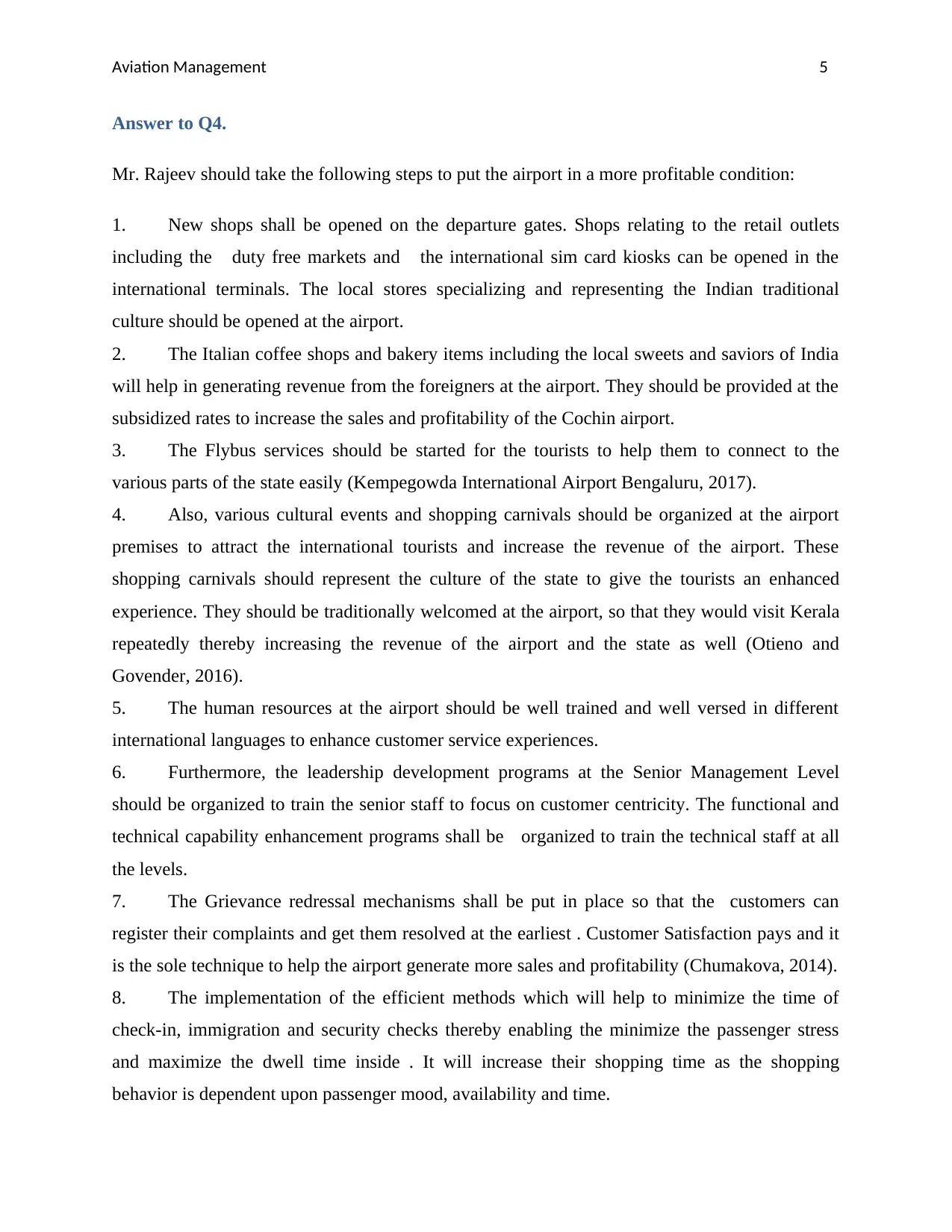
Aviation Management 5
Answer to Q4.
Mr. Rajeev should take the following steps to put the airport in a more profitable condition:
1. New shops shall be opened on the departure gates. Shops relating to the retail outlets
including the duty free markets and the international sim card kiosks can be opened in the
international terminals. The local stores specializing and representing the Indian traditional
culture should be opened at the airport.
2. The Italian coffee shops and bakery items including the local sweets and saviors of India
will help in generating revenue from the foreigners at the airport. They should be provided at the
subsidized rates to increase the sales and profitability of the Cochin airport.
3. The Flybus services should be started for the tourists to help them to connect to the
various parts of the state easily (Kempegowda International Airport Bengaluru, 2017).
4. Also, various cultural events and shopping carnivals should be organized at the airport
premises to attract the international tourists and increase the revenue of the airport. These
shopping carnivals should represent the culture of the state to give the tourists an enhanced
experience. They should be traditionally welcomed at the airport, so that they would visit Kerala
repeatedly thereby increasing the revenue of the airport and the state as well (Otieno and
Govender, 2016).
5. The human resources at the airport should be well trained and well versed in different
international languages to enhance customer service experiences.
6. Furthermore, the leadership development programs at the Senior Management Level
should be organized to train the senior staff to focus on customer centricity. The functional and
technical capability enhancement programs shall be organized to train the technical staff at all
the levels.
7. The Grievance redressal mechanisms shall be put in place so that the customers can
register their complaints and get them resolved at the earliest . Customer Satisfaction pays and it
is the sole technique to help the airport generate more sales and profitability (Chumakova, 2014).
8. The implementation of the efficient methods which will help to minimize the time of
check-in, immigration and security checks thereby enabling the minimize the passenger stress
and maximize the dwell time inside . It will increase their shopping time as the shopping
behavior is dependent upon passenger mood, availability and time.
Answer to Q4.
Mr. Rajeev should take the following steps to put the airport in a more profitable condition:
1. New shops shall be opened on the departure gates. Shops relating to the retail outlets
including the duty free markets and the international sim card kiosks can be opened in the
international terminals. The local stores specializing and representing the Indian traditional
culture should be opened at the airport.
2. The Italian coffee shops and bakery items including the local sweets and saviors of India
will help in generating revenue from the foreigners at the airport. They should be provided at the
subsidized rates to increase the sales and profitability of the Cochin airport.
3. The Flybus services should be started for the tourists to help them to connect to the
various parts of the state easily (Kempegowda International Airport Bengaluru, 2017).
4. Also, various cultural events and shopping carnivals should be organized at the airport
premises to attract the international tourists and increase the revenue of the airport. These
shopping carnivals should represent the culture of the state to give the tourists an enhanced
experience. They should be traditionally welcomed at the airport, so that they would visit Kerala
repeatedly thereby increasing the revenue of the airport and the state as well (Otieno and
Govender, 2016).
5. The human resources at the airport should be well trained and well versed in different
international languages to enhance customer service experiences.
6. Furthermore, the leadership development programs at the Senior Management Level
should be organized to train the senior staff to focus on customer centricity. The functional and
technical capability enhancement programs shall be organized to train the technical staff at all
the levels.
7. The Grievance redressal mechanisms shall be put in place so that the customers can
register their complaints and get them resolved at the earliest . Customer Satisfaction pays and it
is the sole technique to help the airport generate more sales and profitability (Chumakova, 2014).
8. The implementation of the efficient methods which will help to minimize the time of
check-in, immigration and security checks thereby enabling the minimize the passenger stress
and maximize the dwell time inside . It will increase their shopping time as the shopping
behavior is dependent upon passenger mood, availability and time.
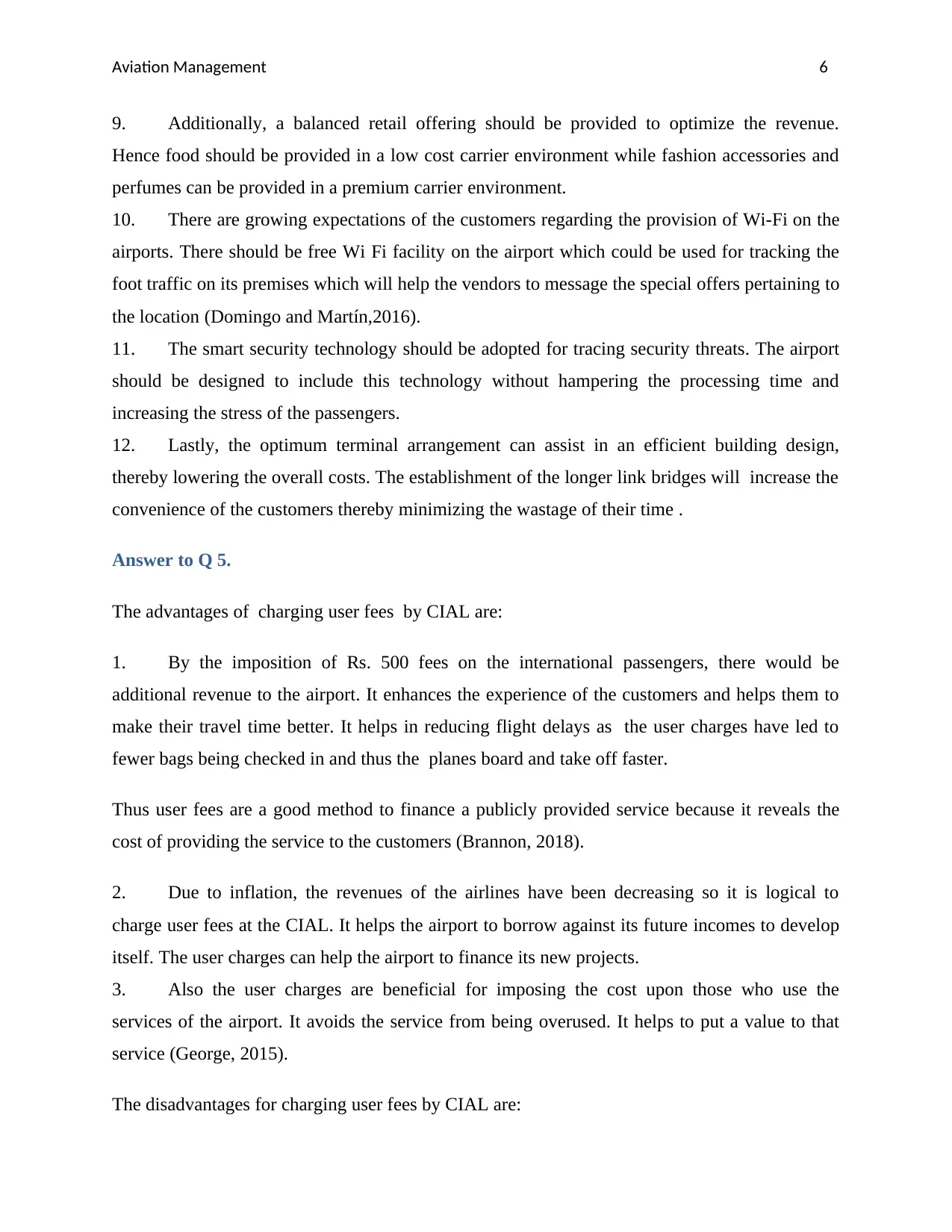
Aviation Management 6
9. Additionally, a balanced retail offering should be provided to optimize the revenue.
Hence food should be provided in a low cost carrier environment while fashion accessories and
perfumes can be provided in a premium carrier environment.
10. There are growing expectations of the customers regarding the provision of Wi-Fi on the
airports. There should be free Wi Fi facility on the airport which could be used for tracking the
foot traffic on its premises which will help the vendors to message the special offers pertaining to
the location (Domingo and Martín,2016).
11. The smart security technology should be adopted for tracing security threats. The airport
should be designed to include this technology without hampering the processing time and
increasing the stress of the passengers.
12. Lastly, the optimum terminal arrangement can assist in an efficient building design,
thereby lowering the overall costs. The establishment of the longer link bridges will increase the
convenience of the customers thereby minimizing the wastage of their time .
Answer to Q 5.
The advantages of charging user fees by CIAL are:
1. By the imposition of Rs. 500 fees on the international passengers, there would be
additional revenue to the airport. It enhances the experience of the customers and helps them to
make their travel time better. It helps in reducing flight delays as the user charges have led to
fewer bags being checked in and thus the planes board and take off faster.
Thus user fees are a good method to finance a publicly provided service because it reveals the
cost of providing the service to the customers (Brannon, 2018).
2. Due to inflation, the revenues of the airlines have been decreasing so it is logical to
charge user fees at the CIAL. It helps the airport to borrow against its future incomes to develop
itself. The user charges can help the airport to finance its new projects.
3. Also the user charges are beneficial for imposing the cost upon those who use the
services of the airport. It avoids the service from being overused. It helps to put a value to that
service (George, 2015).
The disadvantages for charging user fees by CIAL are:
9. Additionally, a balanced retail offering should be provided to optimize the revenue.
Hence food should be provided in a low cost carrier environment while fashion accessories and
perfumes can be provided in a premium carrier environment.
10. There are growing expectations of the customers regarding the provision of Wi-Fi on the
airports. There should be free Wi Fi facility on the airport which could be used for tracking the
foot traffic on its premises which will help the vendors to message the special offers pertaining to
the location (Domingo and Martín,2016).
11. The smart security technology should be adopted for tracing security threats. The airport
should be designed to include this technology without hampering the processing time and
increasing the stress of the passengers.
12. Lastly, the optimum terminal arrangement can assist in an efficient building design,
thereby lowering the overall costs. The establishment of the longer link bridges will increase the
convenience of the customers thereby minimizing the wastage of their time .
Answer to Q 5.
The advantages of charging user fees by CIAL are:
1. By the imposition of Rs. 500 fees on the international passengers, there would be
additional revenue to the airport. It enhances the experience of the customers and helps them to
make their travel time better. It helps in reducing flight delays as the user charges have led to
fewer bags being checked in and thus the planes board and take off faster.
Thus user fees are a good method to finance a publicly provided service because it reveals the
cost of providing the service to the customers (Brannon, 2018).
2. Due to inflation, the revenues of the airlines have been decreasing so it is logical to
charge user fees at the CIAL. It helps the airport to borrow against its future incomes to develop
itself. The user charges can help the airport to finance its new projects.
3. Also the user charges are beneficial for imposing the cost upon those who use the
services of the airport. It avoids the service from being overused. It helps to put a value to that
service (George, 2015).
The disadvantages for charging user fees by CIAL are:
Paraphrase This Document
Need a fresh take? Get an instant paraphrase of this document with our AI Paraphraser
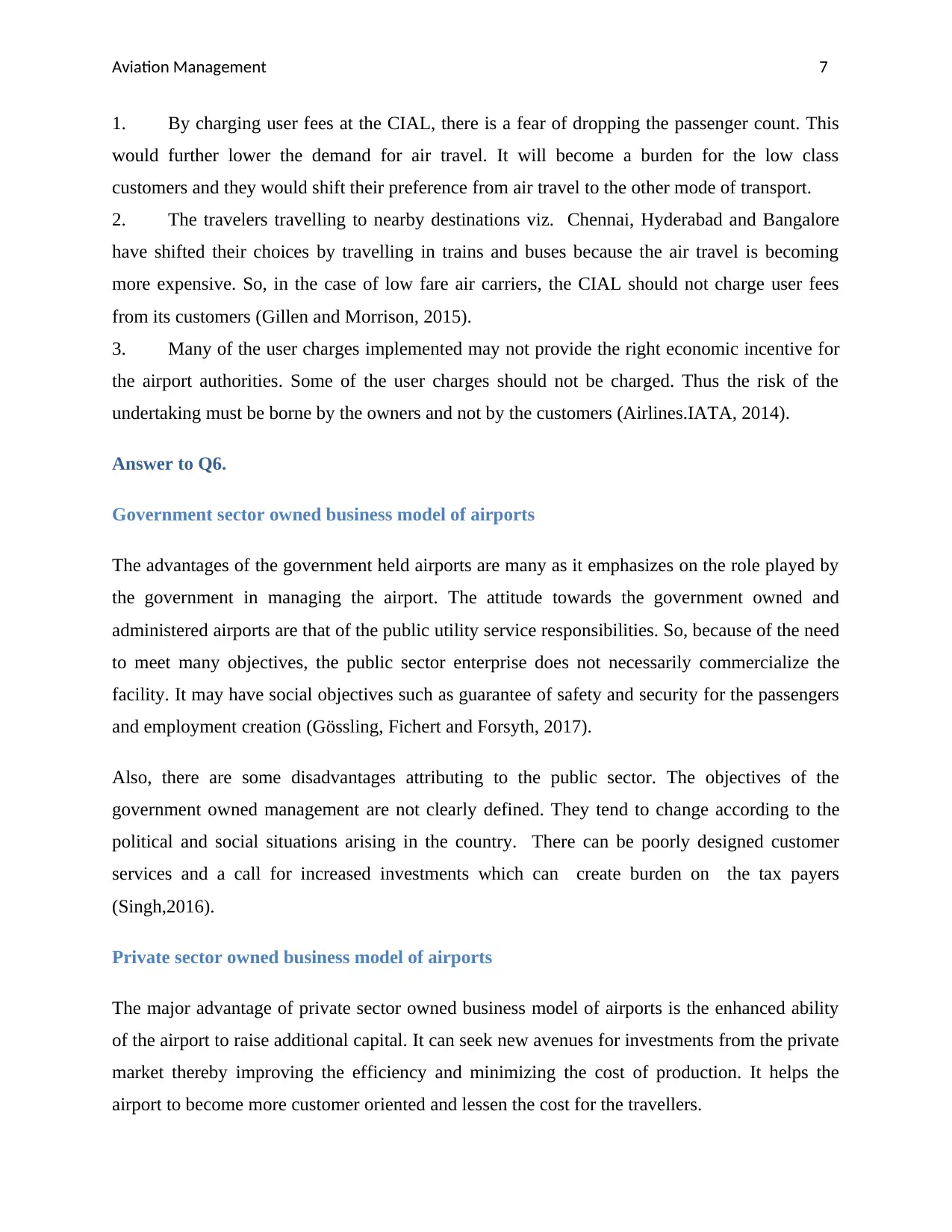
Aviation Management 7
1. By charging user fees at the CIAL, there is a fear of dropping the passenger count. This
would further lower the demand for air travel. It will become a burden for the low class
customers and they would shift their preference from air travel to the other mode of transport.
2. The travelers travelling to nearby destinations viz. Chennai, Hyderabad and Bangalore
have shifted their choices by travelling in trains and buses because the air travel is becoming
more expensive. So, in the case of low fare air carriers, the CIAL should not charge user fees
from its customers (Gillen and Morrison, 2015).
3. Many of the user charges implemented may not provide the right economic incentive for
the airport authorities. Some of the user charges should not be charged. Thus the risk of the
undertaking must be borne by the owners and not by the customers (Airlines.IATA, 2014).
Answer to Q6.
Government sector owned business model of airports
The advantages of the government held airports are many as it emphasizes on the role played by
the government in managing the airport. The attitude towards the government owned and
administered airports are that of the public utility service responsibilities. So, because of the need
to meet many objectives, the public sector enterprise does not necessarily commercialize the
facility. It may have social objectives such as guarantee of safety and security for the passengers
and employment creation (Gössling, Fichert and Forsyth, 2017).
Also, there are some disadvantages attributing to the public sector. The objectives of the
government owned management are not clearly defined. They tend to change according to the
political and social situations arising in the country. There can be poorly designed customer
services and a call for increased investments which can create burden on the tax payers
(Singh,2016).
Private sector owned business model of airports
The major advantage of private sector owned business model of airports is the enhanced ability
of the airport to raise additional capital. It can seek new avenues for investments from the private
market thereby improving the efficiency and minimizing the cost of production. It helps the
airport to become more customer oriented and lessen the cost for the travellers.
1. By charging user fees at the CIAL, there is a fear of dropping the passenger count. This
would further lower the demand for air travel. It will become a burden for the low class
customers and they would shift their preference from air travel to the other mode of transport.
2. The travelers travelling to nearby destinations viz. Chennai, Hyderabad and Bangalore
have shifted their choices by travelling in trains and buses because the air travel is becoming
more expensive. So, in the case of low fare air carriers, the CIAL should not charge user fees
from its customers (Gillen and Morrison, 2015).
3. Many of the user charges implemented may not provide the right economic incentive for
the airport authorities. Some of the user charges should not be charged. Thus the risk of the
undertaking must be borne by the owners and not by the customers (Airlines.IATA, 2014).
Answer to Q6.
Government sector owned business model of airports
The advantages of the government held airports are many as it emphasizes on the role played by
the government in managing the airport. The attitude towards the government owned and
administered airports are that of the public utility service responsibilities. So, because of the need
to meet many objectives, the public sector enterprise does not necessarily commercialize the
facility. It may have social objectives such as guarantee of safety and security for the passengers
and employment creation (Gössling, Fichert and Forsyth, 2017).
Also, there are some disadvantages attributing to the public sector. The objectives of the
government owned management are not clearly defined. They tend to change according to the
political and social situations arising in the country. There can be poorly designed customer
services and a call for increased investments which can create burden on the tax payers
(Singh,2016).
Private sector owned business model of airports
The major advantage of private sector owned business model of airports is the enhanced ability
of the airport to raise additional capital. It can seek new avenues for investments from the private
market thereby improving the efficiency and minimizing the cost of production. It helps the
airport to become more customer oriented and lessen the cost for the travellers.

Aviation Management 8
Irrespective of the potential benefits of privatization of airports, it also increases the risk which is
disadvantageous for the public policy. As the airports are observed as the crucial catalysts for the
local economic growth, so the public believes that the government should play an important role
in evolving and monitoring the administration of the airports. So, the public at large trusts the
government by keeping it involved in the regulation and supervision of the airport. Without the
involvement of the government, privatization of the airports would bring more user charges and
landing fees which would result in higher ticket charges for the customers (Gleave and Move,
2016).
However, CIAL should be built and operated by the private sector as it has more advantages and
would add on to the efficiency of the airport services. It can enter into agreements with
government enterprises to provide the services to its customers at subsidized rates thereby
helping it becoming customer centric (Tomová, 2017).
Answer to Q7.
The perfect storm in the context of Zurich airport had arisen due many factors. Firstly, after the
9/11 terror attacks, very few passengers passed through the airport as most of the flights between
US and Switzerland were cancelled. As a result the travellers travelling through the airlines were
reluctant.
Secondly, the financial backer of the airport’s infrastructure expansion project amounting to SFr.
2.2 Billion cancelled the project due to which several half-finished projects were left with
indeterminate future (European Commission, 2017).
Additionally, in the early October, the bankruptcy of Switzerland’s national airline removed 40
% of the airline traffic and prospective revenue. To add on the misery, after a month an airplane
crashed while the taking off in which all the passengers and pilots were killed (Next Gen Leaders
Club, 2017).
Also, Sussie, an arm of the Swiss Aviation Insurance pool and the provider of war and terrorism
insurance of the Zurich airport canceled its policy . Without the insurance, the Zurich airport
would be compelled to withdraw its operations and forced to close.
Irrespective of the potential benefits of privatization of airports, it also increases the risk which is
disadvantageous for the public policy. As the airports are observed as the crucial catalysts for the
local economic growth, so the public believes that the government should play an important role
in evolving and monitoring the administration of the airports. So, the public at large trusts the
government by keeping it involved in the regulation and supervision of the airport. Without the
involvement of the government, privatization of the airports would bring more user charges and
landing fees which would result in higher ticket charges for the customers (Gleave and Move,
2016).
However, CIAL should be built and operated by the private sector as it has more advantages and
would add on to the efficiency of the airport services. It can enter into agreements with
government enterprises to provide the services to its customers at subsidized rates thereby
helping it becoming customer centric (Tomová, 2017).
Answer to Q7.
The perfect storm in the context of Zurich airport had arisen due many factors. Firstly, after the
9/11 terror attacks, very few passengers passed through the airport as most of the flights between
US and Switzerland were cancelled. As a result the travellers travelling through the airlines were
reluctant.
Secondly, the financial backer of the airport’s infrastructure expansion project amounting to SFr.
2.2 Billion cancelled the project due to which several half-finished projects were left with
indeterminate future (European Commission, 2017).
Additionally, in the early October, the bankruptcy of Switzerland’s national airline removed 40
% of the airline traffic and prospective revenue. To add on the misery, after a month an airplane
crashed while the taking off in which all the passengers and pilots were killed (Next Gen Leaders
Club, 2017).
Also, Sussie, an arm of the Swiss Aviation Insurance pool and the provider of war and terrorism
insurance of the Zurich airport canceled its policy . Without the insurance, the Zurich airport
would be compelled to withdraw its operations and forced to close.
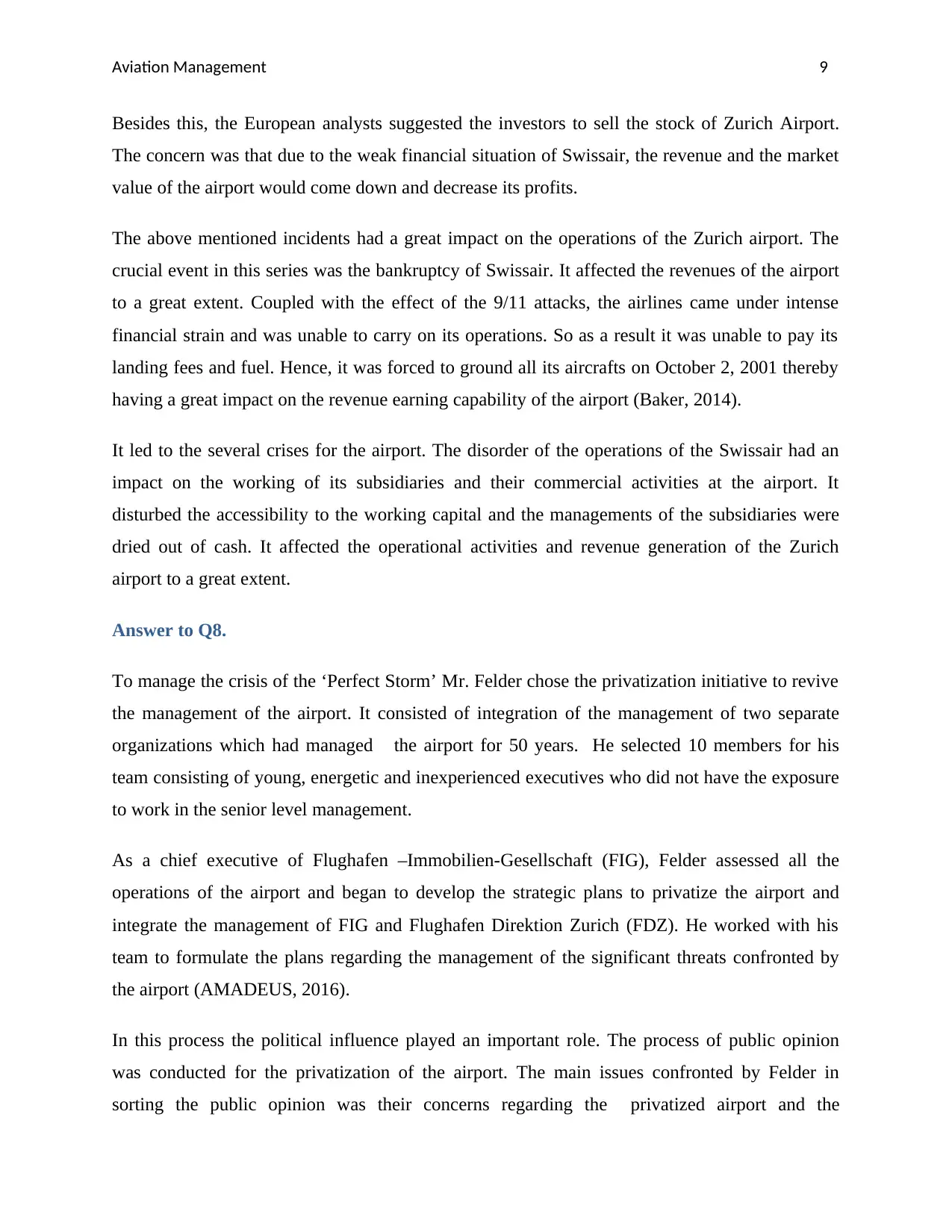
Aviation Management 9
Besides this, the European analysts suggested the investors to sell the stock of Zurich Airport.
The concern was that due to the weak financial situation of Swissair, the revenue and the market
value of the airport would come down and decrease its profits.
The above mentioned incidents had a great impact on the operations of the Zurich airport. The
crucial event in this series was the bankruptcy of Swissair. It affected the revenues of the airport
to a great extent. Coupled with the effect of the 9/11 attacks, the airlines came under intense
financial strain and was unable to carry on its operations. So as a result it was unable to pay its
landing fees and fuel. Hence, it was forced to ground all its aircrafts on October 2, 2001 thereby
having a great impact on the revenue earning capability of the airport (Baker, 2014).
It led to the several crises for the airport. The disorder of the operations of the Swissair had an
impact on the working of its subsidiaries and their commercial activities at the airport. It
disturbed the accessibility to the working capital and the managements of the subsidiaries were
dried out of cash. It affected the operational activities and revenue generation of the Zurich
airport to a great extent.
Answer to Q8.
To manage the crisis of the ‘Perfect Storm’ Mr. Felder chose the privatization initiative to revive
the management of the airport. It consisted of integration of the management of two separate
organizations which had managed the airport for 50 years. He selected 10 members for his
team consisting of young, energetic and inexperienced executives who did not have the exposure
to work in the senior level management.
As a chief executive of Flughafen –Immobilien-Gesellschaft (FIG), Felder assessed all the
operations of the airport and began to develop the strategic plans to privatize the airport and
integrate the management of FIG and Flughafen Direktion Zurich (FDZ). He worked with his
team to formulate the plans regarding the management of the significant threats confronted by
the airport (AMADEUS, 2016).
In this process the political influence played an important role. The process of public opinion
was conducted for the privatization of the airport. The main issues confronted by Felder in
sorting the public opinion was their concerns regarding the privatized airport and the
Besides this, the European analysts suggested the investors to sell the stock of Zurich Airport.
The concern was that due to the weak financial situation of Swissair, the revenue and the market
value of the airport would come down and decrease its profits.
The above mentioned incidents had a great impact on the operations of the Zurich airport. The
crucial event in this series was the bankruptcy of Swissair. It affected the revenues of the airport
to a great extent. Coupled with the effect of the 9/11 attacks, the airlines came under intense
financial strain and was unable to carry on its operations. So as a result it was unable to pay its
landing fees and fuel. Hence, it was forced to ground all its aircrafts on October 2, 2001 thereby
having a great impact on the revenue earning capability of the airport (Baker, 2014).
It led to the several crises for the airport. The disorder of the operations of the Swissair had an
impact on the working of its subsidiaries and their commercial activities at the airport. It
disturbed the accessibility to the working capital and the managements of the subsidiaries were
dried out of cash. It affected the operational activities and revenue generation of the Zurich
airport to a great extent.
Answer to Q8.
To manage the crisis of the ‘Perfect Storm’ Mr. Felder chose the privatization initiative to revive
the management of the airport. It consisted of integration of the management of two separate
organizations which had managed the airport for 50 years. He selected 10 members for his
team consisting of young, energetic and inexperienced executives who did not have the exposure
to work in the senior level management.
As a chief executive of Flughafen –Immobilien-Gesellschaft (FIG), Felder assessed all the
operations of the airport and began to develop the strategic plans to privatize the airport and
integrate the management of FIG and Flughafen Direktion Zurich (FDZ). He worked with his
team to formulate the plans regarding the management of the significant threats confronted by
the airport (AMADEUS, 2016).
In this process the political influence played an important role. The process of public opinion
was conducted for the privatization of the airport. The main issues confronted by Felder in
sorting the public opinion was their concerns regarding the privatized airport and the
Secure Best Marks with AI Grader
Need help grading? Try our AI Grader for instant feedback on your assignments.
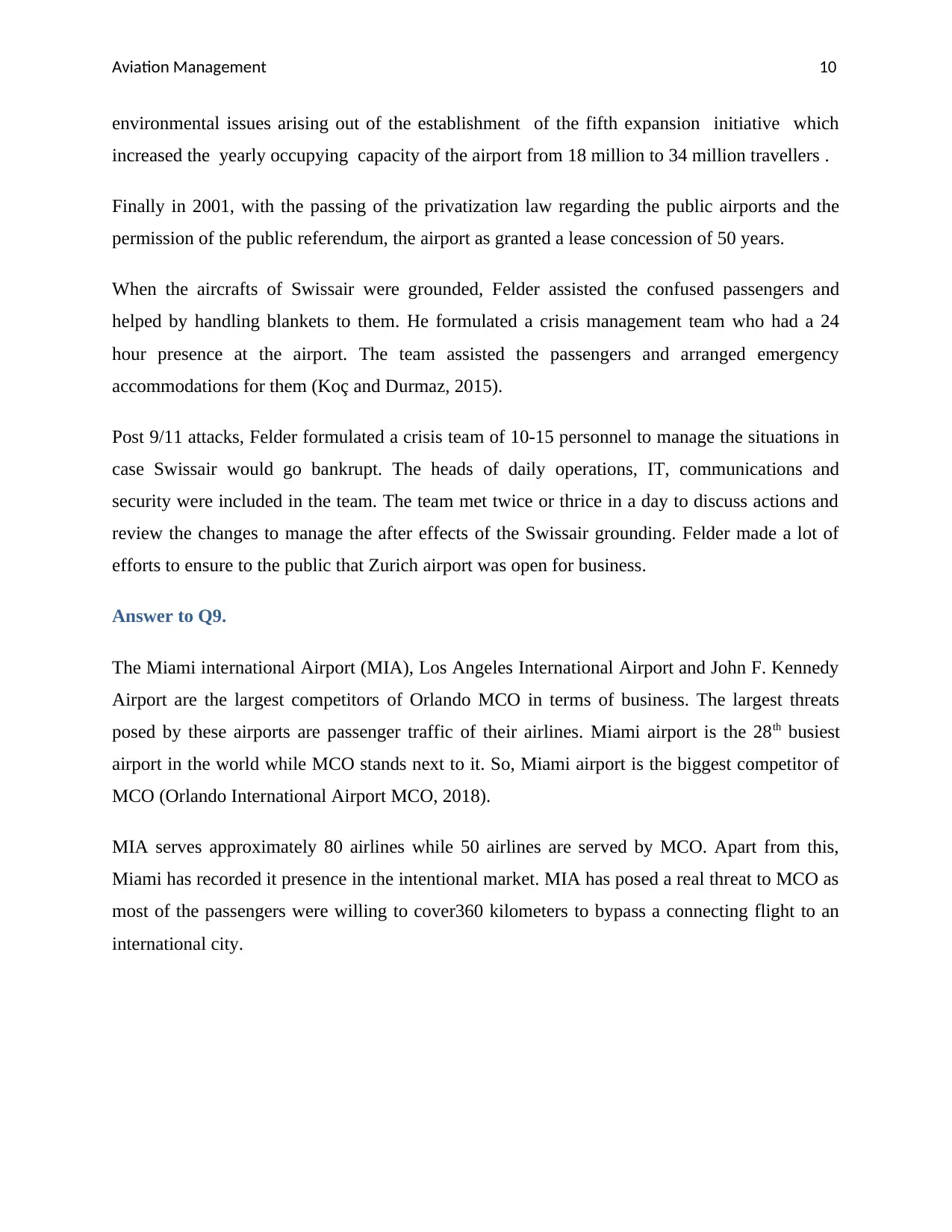
Aviation Management 10
environmental issues arising out of the establishment of the fifth expansion initiative which
increased the yearly occupying capacity of the airport from 18 million to 34 million travellers .
Finally in 2001, with the passing of the privatization law regarding the public airports and the
permission of the public referendum, the airport as granted a lease concession of 50 years.
When the aircrafts of Swissair were grounded, Felder assisted the confused passengers and
helped by handling blankets to them. He formulated a crisis management team who had a 24
hour presence at the airport. The team assisted the passengers and arranged emergency
accommodations for them (Koç and Durmaz, 2015).
Post 9/11 attacks, Felder formulated a crisis team of 10-15 personnel to manage the situations in
case Swissair would go bankrupt. The heads of daily operations, IT, communications and
security were included in the team. The team met twice or thrice in a day to discuss actions and
review the changes to manage the after effects of the Swissair grounding. Felder made a lot of
efforts to ensure to the public that Zurich airport was open for business.
Answer to Q9.
The Miami international Airport (MIA), Los Angeles International Airport and John F. Kennedy
Airport are the largest competitors of Orlando MCO in terms of business. The largest threats
posed by these airports are passenger traffic of their airlines. Miami airport is the 28th busiest
airport in the world while MCO stands next to it. So, Miami airport is the biggest competitor of
MCO (Orlando International Airport MCO, 2018).
MIA serves approximately 80 airlines while 50 airlines are served by MCO. Apart from this,
Miami has recorded it presence in the intentional market. MIA has posed a real threat to MCO as
most of the passengers were willing to cover360 kilometers to bypass a connecting flight to an
international city.
environmental issues arising out of the establishment of the fifth expansion initiative which
increased the yearly occupying capacity of the airport from 18 million to 34 million travellers .
Finally in 2001, with the passing of the privatization law regarding the public airports and the
permission of the public referendum, the airport as granted a lease concession of 50 years.
When the aircrafts of Swissair were grounded, Felder assisted the confused passengers and
helped by handling blankets to them. He formulated a crisis management team who had a 24
hour presence at the airport. The team assisted the passengers and arranged emergency
accommodations for them (Koç and Durmaz, 2015).
Post 9/11 attacks, Felder formulated a crisis team of 10-15 personnel to manage the situations in
case Swissair would go bankrupt. The heads of daily operations, IT, communications and
security were included in the team. The team met twice or thrice in a day to discuss actions and
review the changes to manage the after effects of the Swissair grounding. Felder made a lot of
efforts to ensure to the public that Zurich airport was open for business.
Answer to Q9.
The Miami international Airport (MIA), Los Angeles International Airport and John F. Kennedy
Airport are the largest competitors of Orlando MCO in terms of business. The largest threats
posed by these airports are passenger traffic of their airlines. Miami airport is the 28th busiest
airport in the world while MCO stands next to it. So, Miami airport is the biggest competitor of
MCO (Orlando International Airport MCO, 2018).
MIA serves approximately 80 airlines while 50 airlines are served by MCO. Apart from this,
Miami has recorded it presence in the intentional market. MIA has posed a real threat to MCO as
most of the passengers were willing to cover360 kilometers to bypass a connecting flight to an
international city.

Aviation Management 11
Answer to Q10.
The value propositions of MCO in the context of airlines are many. Since Orlando International
Airport is the 13th busiest airport in the country and 29th busiest airport worldwide, so its four
parallel runways and 96 gates are capable of handling the largest aircrafts. Due to its bigger
available space as compared to its competitors, it handles more than 30 domestic and
international aircrafts which results in the lowest cost per passenger at the MCO airport.
In the context of Emirates route planning, the value of proposition of MCO can be helpful. Since
Emirates operate in the Middle East Countries, the airlines cover a long distance from the middle
east to U.S., so the airlines would get a sufficient space for its aircraft to be parked for longer
hours( Kamarudin, n.d.).
The second value proposition of MCO is that with the help of its operational efficiency and
flexibility of the IT systems, the airport could enhance the experience of the passengers as well
as the airlines. These are important parameters as they have a great influence on the capability of
the airport to deliver effective operations on the ground level to smoothen the management of the
airlines as well as to provide a comfortable journey to the passengers (Nõmmik and Antov ,
2017).
In the context of Emirates route planning, this value proposition of MCO can assist in enhancing
the experience of the customers of the Emirates as well as that of the airlines. With the help of its
high tech infrastructure including easy accessibility to the highly trained and qualified workforce
and efficient systems to manage and regulate the internal management of the airport, the airlines
would be able to manage their operations efficiently (Accenture, 2017).
Lastly, with the help of trained and qualified workforce, the airport can access to the customers
of the airlines in a better way. In this manner, the airport would be more customers centric and
would help Emirates in generating more revenue. However, due to the pre conceived notions of
the customers, the airport or the airlines might not be able to enhance their experiences
(Sricharoenpramong, 2018).
Answer to Q10.
The value propositions of MCO in the context of airlines are many. Since Orlando International
Airport is the 13th busiest airport in the country and 29th busiest airport worldwide, so its four
parallel runways and 96 gates are capable of handling the largest aircrafts. Due to its bigger
available space as compared to its competitors, it handles more than 30 domestic and
international aircrafts which results in the lowest cost per passenger at the MCO airport.
In the context of Emirates route planning, the value of proposition of MCO can be helpful. Since
Emirates operate in the Middle East Countries, the airlines cover a long distance from the middle
east to U.S., so the airlines would get a sufficient space for its aircraft to be parked for longer
hours( Kamarudin, n.d.).
The second value proposition of MCO is that with the help of its operational efficiency and
flexibility of the IT systems, the airport could enhance the experience of the passengers as well
as the airlines. These are important parameters as they have a great influence on the capability of
the airport to deliver effective operations on the ground level to smoothen the management of the
airlines as well as to provide a comfortable journey to the passengers (Nõmmik and Antov ,
2017).
In the context of Emirates route planning, this value proposition of MCO can assist in enhancing
the experience of the customers of the Emirates as well as that of the airlines. With the help of its
high tech infrastructure including easy accessibility to the highly trained and qualified workforce
and efficient systems to manage and regulate the internal management of the airport, the airlines
would be able to manage their operations efficiently (Accenture, 2017).
Lastly, with the help of trained and qualified workforce, the airport can access to the customers
of the airlines in a better way. In this manner, the airport would be more customers centric and
would help Emirates in generating more revenue. However, due to the pre conceived notions of
the customers, the airport or the airlines might not be able to enhance their experiences
(Sricharoenpramong, 2018).

Aviation Management 12
References
Accenture (2017) Digital Transformation Initiative Aviation, Travel and Tourism Industry report
[online] Available from:
https://www.accenture.com/t20170116T084449__w__/us-en/_acnmedia/Accenture/Conversion-
Assets/WEF/PDF/Accenture-DTI-Aviation-Travel-and-Tourism-Industry-White-Paper.pdf
[Accessed 13th April 2018].
Airlines.IATA(2014) Airport charges: Paying the price [online] Available from:
http://airlines.iata.org/analysis/airport-charges-paying-the-price [Accessed 12th April 2018].
AMADEUS(2016) Reinventing the Airport Ecosystem: A new airline industry report [online]
Available
from:http://www.amadeus.com/web/binaries/1333089231764/blobheader=application/
pdf&blobheadername1=Content-Disposition&blobheadervalue1=inline%3B+filename
%3DReinventing+the+Airport+Ecosystem+Final.pdf [Accessed 13th April 2018].
Baker , D.M.A.(2014) The Effects of Terrorism on the Travel and Tourism Industry The Effects
of Terrorism on the Travel and Tourism Industry. International Journal of Religious Tourism
and Pilgrimage. 2(1),pp. 58-67.
Brannon, I. (2018) Of User Fees And Taxes: The Passenger Facility Charge Is A User Fee, And
It Shouldn't Become a Tax. Forbes [online] Available from:
https://www.forbes.com/sites/ikebrannon/2018/01/26/of-user-fees-and-taxes-the-passenger-
facility-charge-is-a-user-fee-and-it-shouldnt-become-a-tax/#34927b9a35c4 [Accessed 12th April
2018].
Cheng, A . (2015) Hong Kong must exhaust all other options before building third runway. South
China Morning Post Economy [online] Available from: http://www.scmp.com/comment/insight-
References
Accenture (2017) Digital Transformation Initiative Aviation, Travel and Tourism Industry report
[online] Available from:
https://www.accenture.com/t20170116T084449__w__/us-en/_acnmedia/Accenture/Conversion-
Assets/WEF/PDF/Accenture-DTI-Aviation-Travel-and-Tourism-Industry-White-Paper.pdf
[Accessed 13th April 2018].
Airlines.IATA(2014) Airport charges: Paying the price [online] Available from:
http://airlines.iata.org/analysis/airport-charges-paying-the-price [Accessed 12th April 2018].
AMADEUS(2016) Reinventing the Airport Ecosystem: A new airline industry report [online]
Available
from:http://www.amadeus.com/web/binaries/1333089231764/blobheader=application/
pdf&blobheadername1=Content-Disposition&blobheadervalue1=inline%3B+filename
%3DReinventing+the+Airport+Ecosystem+Final.pdf [Accessed 13th April 2018].
Baker , D.M.A.(2014) The Effects of Terrorism on the Travel and Tourism Industry The Effects
of Terrorism on the Travel and Tourism Industry. International Journal of Religious Tourism
and Pilgrimage. 2(1),pp. 58-67.
Brannon, I. (2018) Of User Fees And Taxes: The Passenger Facility Charge Is A User Fee, And
It Shouldn't Become a Tax. Forbes [online] Available from:
https://www.forbes.com/sites/ikebrannon/2018/01/26/of-user-fees-and-taxes-the-passenger-
facility-charge-is-a-user-fee-and-it-shouldnt-become-a-tax/#34927b9a35c4 [Accessed 12th April
2018].
Cheng, A . (2015) Hong Kong must exhaust all other options before building third runway. South
China Morning Post Economy [online] Available from: http://www.scmp.com/comment/insight-
Paraphrase This Document
Need a fresh take? Get an instant paraphrase of this document with our AI Paraphraser
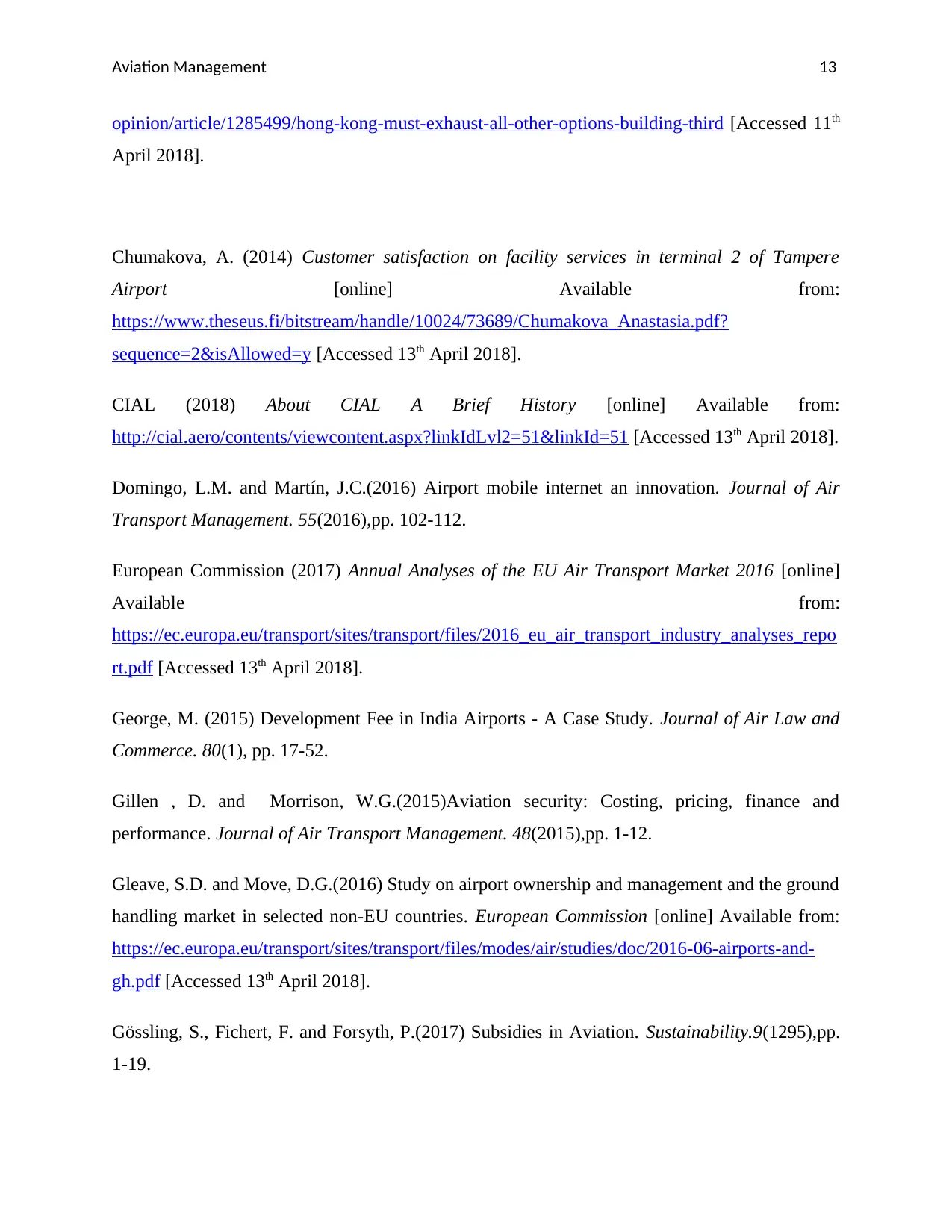
Aviation Management 13
opinion/article/1285499/hong-kong-must-exhaust-all-other-options-building-third [Accessed 11th
April 2018].
Chumakova, A. (2014) Customer satisfaction on facility services in terminal 2 of Tampere
Airport [online] Available from:
https://www.theseus.fi/bitstream/handle/10024/73689/Chumakova_Anastasia.pdf?
sequence=2&isAllowed=y [Accessed 13th April 2018].
CIAL (2018) About CIAL A Brief History [online] Available from:
http://cial.aero/contents/viewcontent.aspx?linkIdLvl2=51&linkId=51 [Accessed 13th April 2018].
Domingo, L.M. and Martín, J.C.(2016) Airport mobile internet an innovation. Journal of Air
Transport Management. 55(2016),pp. 102-112.
European Commission (2017) Annual Analyses of the EU Air Transport Market 2016 [online]
Available from:
https://ec.europa.eu/transport/sites/transport/files/2016_eu_air_transport_industry_analyses_repo
rt.pdf [Accessed 13th April 2018].
George, M. (2015) Development Fee in India Airports - A Case Study. Journal of Air Law and
Commerce. 80(1), pp. 17-52.
Gillen , D. and Morrison, W.G.(2015)Aviation security: Costing, pricing, finance and
performance. Journal of Air Transport Management. 48(2015),pp. 1-12.
Gleave, S.D. and Move, D.G.(2016) Study on airport ownership and management and the ground
handling market in selected non-EU countries. European Commission [online] Available from:
https://ec.europa.eu/transport/sites/transport/files/modes/air/studies/doc/2016-06-airports-and-
gh.pdf [Accessed 13th April 2018].
Gössling, S., Fichert, F. and Forsyth, P.(2017) Subsidies in Aviation. Sustainability.9(1295),pp.
1-19.
opinion/article/1285499/hong-kong-must-exhaust-all-other-options-building-third [Accessed 11th
April 2018].
Chumakova, A. (2014) Customer satisfaction on facility services in terminal 2 of Tampere
Airport [online] Available from:
https://www.theseus.fi/bitstream/handle/10024/73689/Chumakova_Anastasia.pdf?
sequence=2&isAllowed=y [Accessed 13th April 2018].
CIAL (2018) About CIAL A Brief History [online] Available from:
http://cial.aero/contents/viewcontent.aspx?linkIdLvl2=51&linkId=51 [Accessed 13th April 2018].
Domingo, L.M. and Martín, J.C.(2016) Airport mobile internet an innovation. Journal of Air
Transport Management. 55(2016),pp. 102-112.
European Commission (2017) Annual Analyses of the EU Air Transport Market 2016 [online]
Available from:
https://ec.europa.eu/transport/sites/transport/files/2016_eu_air_transport_industry_analyses_repo
rt.pdf [Accessed 13th April 2018].
George, M. (2015) Development Fee in India Airports - A Case Study. Journal of Air Law and
Commerce. 80(1), pp. 17-52.
Gillen , D. and Morrison, W.G.(2015)Aviation security: Costing, pricing, finance and
performance. Journal of Air Transport Management. 48(2015),pp. 1-12.
Gleave, S.D. and Move, D.G.(2016) Study on airport ownership and management and the ground
handling market in selected non-EU countries. European Commission [online] Available from:
https://ec.europa.eu/transport/sites/transport/files/modes/air/studies/doc/2016-06-airports-and-
gh.pdf [Accessed 13th April 2018].
Gössling, S., Fichert, F. and Forsyth, P.(2017) Subsidies in Aviation. Sustainability.9(1295),pp.
1-19.
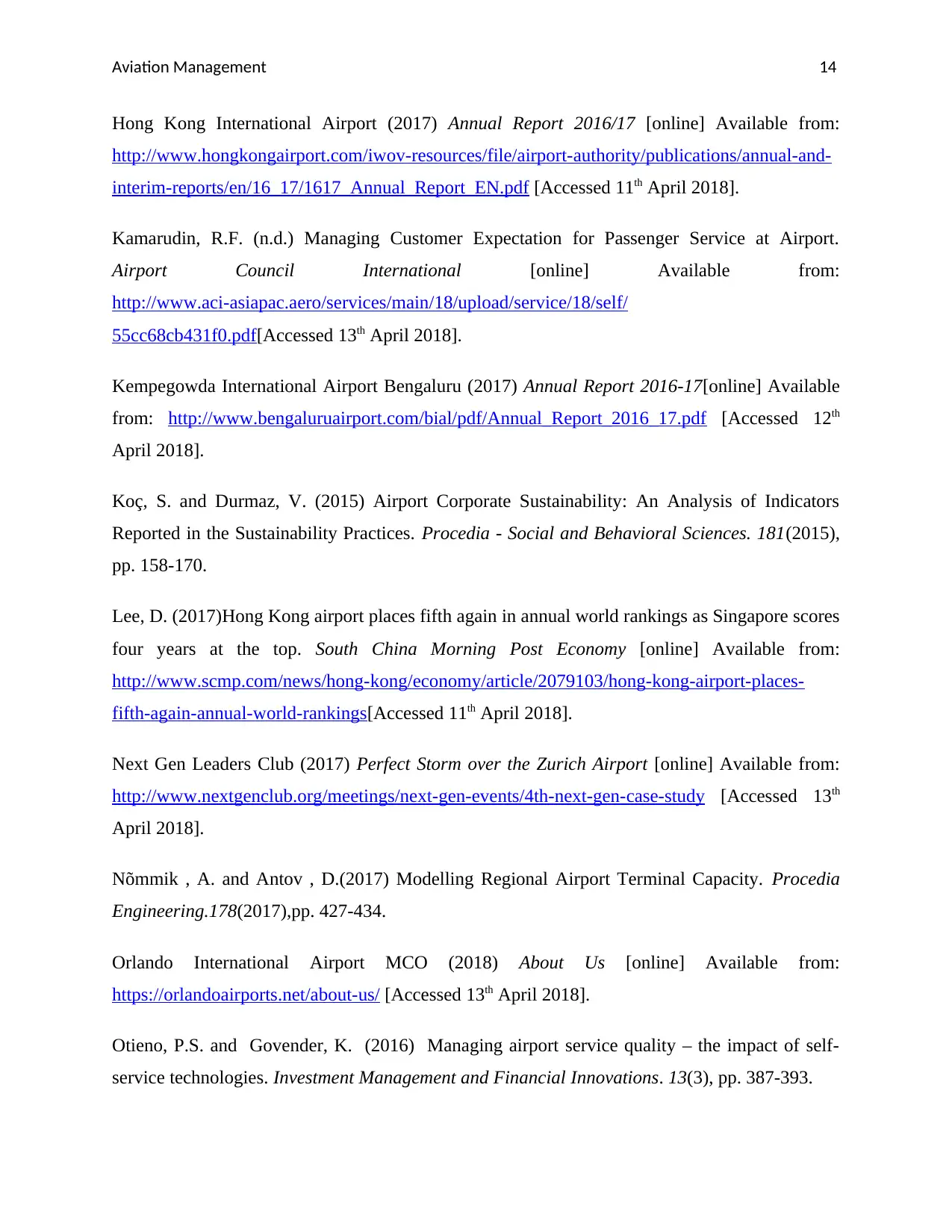
Aviation Management 14
Hong Kong International Airport (2017) Annual Report 2016/17 [online] Available from:
http://www.hongkongairport.com/iwov-resources/file/airport-authority/publications/annual-and-
interim-reports/en/16_17/1617_Annual_Report_EN.pdf [Accessed 11th April 2018].
Kamarudin, R.F. (n.d.) Managing Customer Expectation for Passenger Service at Airport.
Airport Council International [online] Available from:
http://www.aci-asiapac.aero/services/main/18/upload/service/18/self/
55cc68cb431f0.pdf[Accessed 13th April 2018].
Kempegowda International Airport Bengaluru (2017) Annual Report 2016-17[online] Available
from: http://www.bengaluruairport.com/bial/pdf/Annual_Report_2016_17.pdf [Accessed 12th
April 2018].
Koç, S. and Durmaz, V. (2015) Airport Corporate Sustainability: An Analysis of Indicators
Reported in the Sustainability Practices. Procedia - Social and Behavioral Sciences. 181(2015),
pp. 158-170.
Lee, D. (2017)Hong Kong airport places fifth again in annual world rankings as Singapore scores
four years at the top. South China Morning Post Economy [online] Available from:
http://www.scmp.com/news/hong-kong/economy/article/2079103/hong-kong-airport-places-
fifth-again-annual-world-rankings[Accessed 11th April 2018].
Next Gen Leaders Club (2017) Perfect Storm over the Zurich Airport [online] Available from:
http://www.nextgenclub.org/meetings/next-gen-events/4th-next-gen-case-study [Accessed 13th
April 2018].
Nõmmik , A. and Antov , D.(2017) Modelling Regional Airport Terminal Capacity. Procedia
Engineering.178(2017),pp. 427-434.
Orlando International Airport MCO (2018) About Us [online] Available from:
https://orlandoairports.net/about-us/ [Accessed 13th April 2018].
Otieno, P.S. and Govender, K. (2016) Managing airport service quality – the impact of self-
service technologies. Investment Management and Financial Innovations. 13(3), pp. 387-393.
Hong Kong International Airport (2017) Annual Report 2016/17 [online] Available from:
http://www.hongkongairport.com/iwov-resources/file/airport-authority/publications/annual-and-
interim-reports/en/16_17/1617_Annual_Report_EN.pdf [Accessed 11th April 2018].
Kamarudin, R.F. (n.d.) Managing Customer Expectation for Passenger Service at Airport.
Airport Council International [online] Available from:
http://www.aci-asiapac.aero/services/main/18/upload/service/18/self/
55cc68cb431f0.pdf[Accessed 13th April 2018].
Kempegowda International Airport Bengaluru (2017) Annual Report 2016-17[online] Available
from: http://www.bengaluruairport.com/bial/pdf/Annual_Report_2016_17.pdf [Accessed 12th
April 2018].
Koç, S. and Durmaz, V. (2015) Airport Corporate Sustainability: An Analysis of Indicators
Reported in the Sustainability Practices. Procedia - Social and Behavioral Sciences. 181(2015),
pp. 158-170.
Lee, D. (2017)Hong Kong airport places fifth again in annual world rankings as Singapore scores
four years at the top. South China Morning Post Economy [online] Available from:
http://www.scmp.com/news/hong-kong/economy/article/2079103/hong-kong-airport-places-
fifth-again-annual-world-rankings[Accessed 11th April 2018].
Next Gen Leaders Club (2017) Perfect Storm over the Zurich Airport [online] Available from:
http://www.nextgenclub.org/meetings/next-gen-events/4th-next-gen-case-study [Accessed 13th
April 2018].
Nõmmik , A. and Antov , D.(2017) Modelling Regional Airport Terminal Capacity. Procedia
Engineering.178(2017),pp. 427-434.
Orlando International Airport MCO (2018) About Us [online] Available from:
https://orlandoairports.net/about-us/ [Accessed 13th April 2018].
Otieno, P.S. and Govender, K. (2016) Managing airport service quality – the impact of self-
service technologies. Investment Management and Financial Innovations. 13(3), pp. 387-393.
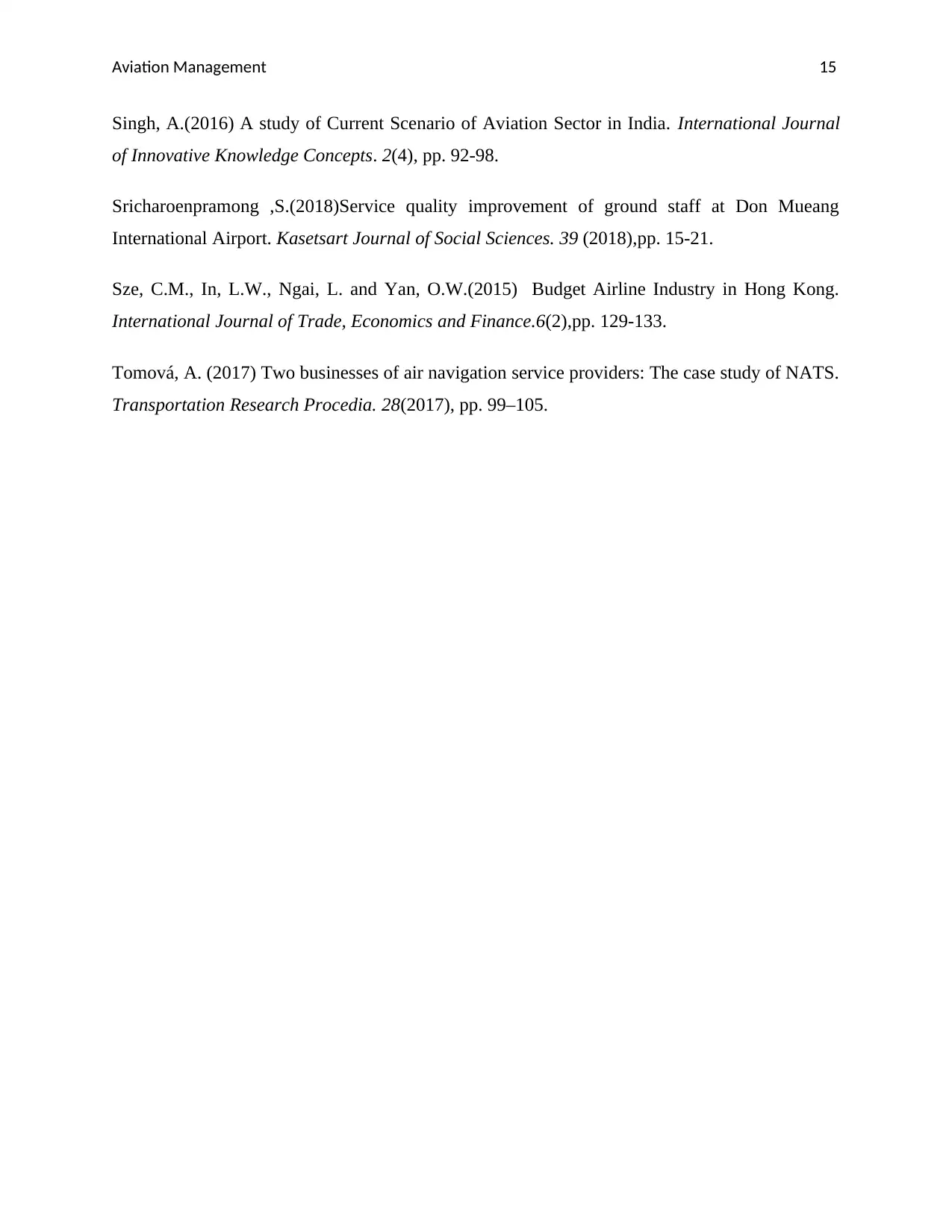
Aviation Management 15
Singh, A.(2016) A study of Current Scenario of Aviation Sector in India. International Journal
of Innovative Knowledge Concepts. 2(4), pp. 92-98.
Sricharoenpramong ,S.(2018)Service quality improvement of ground staff at Don Mueang
International Airport. Kasetsart Journal of Social Sciences. 39 (2018),pp. 15-21.
Sze, C.M., In, L.W., Ngai, L. and Yan, O.W.(2015) Budget Airline Industry in Hong Kong.
International Journal of Trade, Economics and Finance.6(2),pp. 129-133.
Tomová, A. (2017) Two businesses of air navigation service providers: The case study of NATS.
Transportation Research Procedia. 28(2017), pp. 99–105.
Singh, A.(2016) A study of Current Scenario of Aviation Sector in India. International Journal
of Innovative Knowledge Concepts. 2(4), pp. 92-98.
Sricharoenpramong ,S.(2018)Service quality improvement of ground staff at Don Mueang
International Airport. Kasetsart Journal of Social Sciences. 39 (2018),pp. 15-21.
Sze, C.M., In, L.W., Ngai, L. and Yan, O.W.(2015) Budget Airline Industry in Hong Kong.
International Journal of Trade, Economics and Finance.6(2),pp. 129-133.
Tomová, A. (2017) Two businesses of air navigation service providers: The case study of NATS.
Transportation Research Procedia. 28(2017), pp. 99–105.
Secure Best Marks with AI Grader
Need help grading? Try our AI Grader for instant feedback on your assignments.

Aviation Management 16
1 out of 17
Related Documents
Your All-in-One AI-Powered Toolkit for Academic Success.
+13062052269
info@desklib.com
Available 24*7 on WhatsApp / Email
![[object Object]](/_next/static/media/star-bottom.7253800d.svg)
Unlock your academic potential
© 2024 | Zucol Services PVT LTD | All rights reserved.





